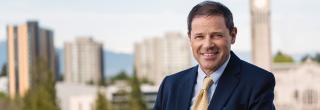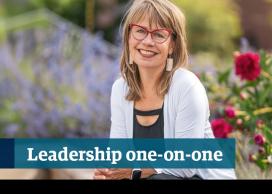Professor Andrew Szeri is the Provost and Vice-President Academic for UBC Vancouver, providing leadership for the university’s academic strategy, budgetary and planning processes. The role also includes overseeing UBC’s academic programs and support functions, faculty affairs, enrolment, sustainability and information technology.
Prior to his appointment at UBC, Professor Szeri served as Vice-Provost for Strategic Academic and Facilities Planning, at the University of California at Berkeley. Professor Szeri was also a professor in the Department of Mechanical Engineering at UC Berkeley, teaching in the areas of fluid mechanics and nonlinear dynamics. He has won several research awards.
Q1. What quality do you most admire in a leader?
AS: I admire leaders who treat people with respect in the decision-making process. We often consult people on options but do not always follow through on explaining why a decision is made. Most people realize that their preferences cannot always be accommodated, but it is easier to accept when they are aware of the reasoning behind a decision.
Q2. What makes you laugh?
AS: I am told I have a dry sense of humour. I like things that are both humorous and faintly ridiculous — a joke that you don’t realize is a joke until two minutes after you’ve heard it. I am a big fan of Monty Python. I also like the BBC sitcoms Are You Being Served? and Absolutely Fabulous.
Q3. Who inspires you, and why?
AS: I am inspired by people who have a passion and a clear sense of purpose. When I was a boy I wanted to spend my life as a crew member on Jacques Cousteau’s boat Calypso. I was therefore somewhat incensed when my parents pushed me to study Spanish rather than French. In my mind, Cousteau’s passion was so evident I wanted to be a part of it.
Q4. What’s the most important lesson you’ve learned?
AS: ‘If at first you don’t succeed, try, try again’. This has been very important in my teaching as well as in my research. If something doesn’t quite work and you try again, there is the possibility to learn for the next time. Last year, I finally managed to demolish a problem in my research that I had begun thinking about 20 years ago, but got stuck 17 years ago. The problem had stayed with me all those years, always in the back of my mind. Last year, I took a sabbatical and literally ‘lived and breathed’ my research. Then, in the fall, I solved the problem. It was an excellent example of the need to persevere.
Q5. What attracted you to UBC? What makes it different?
AS: UBC is a place that has wonderful prospects. There is a great talent base on which to draw from. There is also great support from the provincial government. I think one of UBC’s strengths is its geography — the ‘East meets West’ location creates an exciting environment to create multi-cultural teams of people who can come together to help address global issues.
Q6. How do you like to recharge?
AS: I like to walk… everywhere! I don’t have my own car so I walk as much as I can. I have already walked all over the whole Vancouver campus, as well as from UBC to downtown Vancouver, Stanley Park and False Creek. When I walk, I don’t listen to music and I always make sure to switch my phone off. Walking increases the blood flow to the brain. I find I get a lot of ideas when out walking.
Q7. Who are your favorite writers?
AS: I have two obsessions — modern Japanese writers, and English writers whose work was published in the 20s and 30s. Examples of Japanese authors are: Yukio Mishima, Kenzaburō Ōe and Haruki Murakami. English authors include writers such as Evelyn Waugh or Virginia Woolf.
When I left UC Berkley, a thoughtful colleague gave me a box of works by Canadian authors — Alice Munro and so on, which I am starting to work my way through. I was also recently given a gift from a UBC colleague called Indigenous Writes: A Guide to First Nations, Métis & Inuit issues in Canada.
Q8. What is the best advice you were ever given?
AS: I was given advice by my PhD advisor early in my studies — a professor called Phil Holmes (now a Professor Emeritus at Princeton University). At the time I was thinking about a mathematical problem that I was preparing to work on. Phil told me: “Start doing the problem before you know how to do the problem.” His advice still stays with me today and has grown in significance over the course of my career. He was saying not to spend too much time trying to understand the problem from the outside, before you get into it to learn its true nature. This goes hand in hand with my lesson of ‘try, try again’.
Q9. What do you value in your colleagues?
AS: Candor. I greatly appreciate learning what makes people ‘tick’ and what they find satisfying in their work. This is especially important in a position like the Provost and Vice-President Academic. The more you know about a talented person and what he or she finds a satisfying way to contribute, the easier it is to create the circumstances to allow them to thrive.
Q10. What are your priorities for the Office of the Provost and Vice-President Academic?
AS: One of my top priorities in the coming months is to support Professor Santa Ono as he works to develop our new strategic plan — UBC’s Next Century. Both myself and Professor Gail Murphy, the new Vice-President Research and Innovation, will be joining discussions in support of this process.
Another goal, which I would describe more as a ‘star to steer by’, is exploring how I can work with the Deans to help ensure their success as they lead their Faculties. I want to gain an understanding of all the Faculties, their accomplishments and their challenges. I want to explore how I can use my role as Provost to help them be successful.
Q11. What would you like to be remembered for?
AS: I would like people to remember the things that were accomplished at the university during my time here, as opposed to remembering me personally. I want to have played some sort of role during my time as Provost that helped UBC realize even more of its very considerable potential. My focus is firmly on the institution. If people talk about the great things that were accomplished during my time here, rather than about me, then I will have done my job.
Q12. What do you think the future holds for higher education?
AS: I think the faculty of the future will be more flexible in terms of their job types and activities. Students of the future will expect different modes of interaction and more flexible options of learning. I can see us needing to facilitate new alternative ways of group study and engagement. I also think the future will open up higher education to groups who may previously have had barriers to learning. Although there will be challenges, this is an exciting time for the university. It presents an opportunity for UBC to lead in a way that will allow it to capitalize on all that wonderful not-yet-fully-realized potential.
Published: September 1, 2017
Interviewed by: Chris Sulymka, UBC Internal Communications



